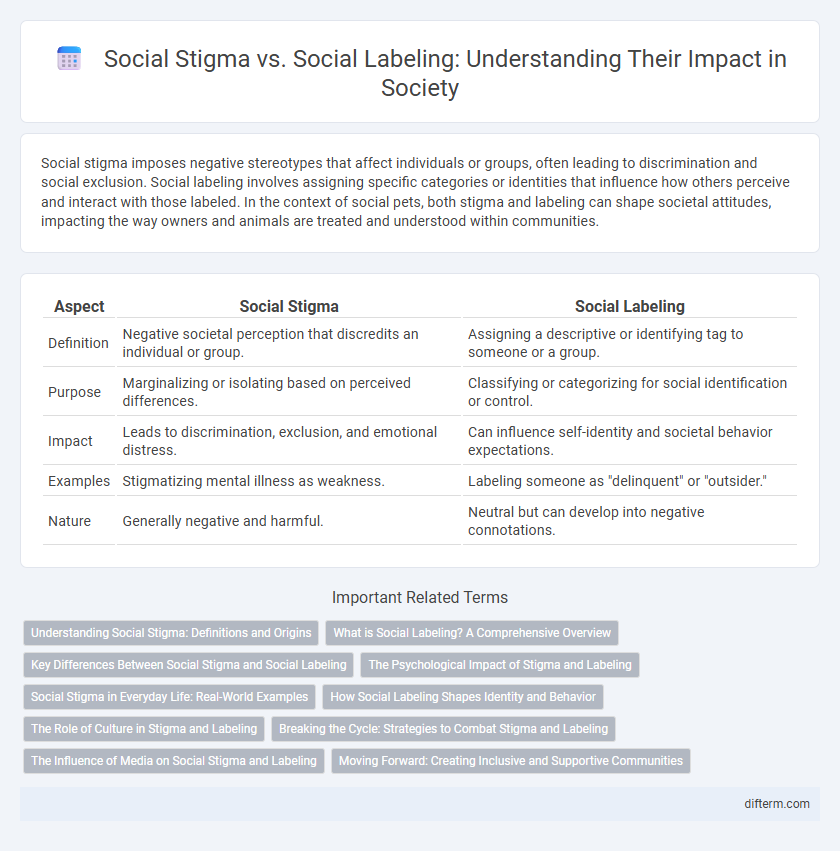Social stigma imposes negative stereotypes that affect individuals or groups, often leading to discrimination and social exclusion. Social labeling involves assigning specific categories or identities that influence how others perceive and interact with those labeled. In the context of social pets, both stigma and labeling can shape societal attitudes, impacting the way owners and animals are treated and understood within communities.
Table of Comparison
| Aspect | Social Stigma | Social Labeling |
|---|---|---|
| Definition | Negative societal perception that discredits an individual or group. | Assigning a descriptive or identifying tag to someone or a group. |
| Purpose | Marginalizing or isolating based on perceived differences. | Classifying or categorizing for social identification or control. |
| Impact | Leads to discrimination, exclusion, and emotional distress. | Can influence self-identity and societal behavior expectations. |
| Examples | Stigmatizing mental illness as weakness. | Labeling someone as "delinquent" or "outsider." |
| Nature | Generally negative and harmful. | Neutral but can develop into negative connotations. |
Understanding Social Stigma: Definitions and Origins
Social stigma refers to the disapproval and discrimination faced by individuals based on attributes deemed undesirable by society, often rooted in cultural, historical, and psychological factors. Social labeling involves categorizing individuals or groups with specific stereotypes, reinforcing negative perceptions and limiting social identity. Understanding these concepts reveals how societal attitudes evolve and impact individuals' experiences and self-conception.
What is Social Labeling? A Comprehensive Overview
Social labeling refers to the process of assigning a specific identity or stereotype to an individual or group based on perceived characteristics, often leading to social categorization and influencing behavior. It plays a crucial role in shaping societal attitudes and interactions by reinforcing certain norms and expectations tied to the label. Understanding social labeling involves analyzing its impact on self-identity, social inclusion, and the perpetuation of social inequalities.
Key Differences Between Social Stigma and Social Labeling
Social stigma involves a negative societal perception that taints an individual's identity, often leading to discrimination and exclusion, whereas social labeling refers to the act of assigning a category or stereotype to a person or group based on specific traits or behaviors. Social stigma carries emotional and psychological consequences, impacting self-esteem and social relationships, while social labeling primarily functions as a cognitive shortcut in social interactions. Understanding the key differences between these concepts is essential for addressing issues related to social judgment and promoting inclusive social environments.
The Psychological Impact of Stigma and Labeling
Social stigma and social labeling profoundly affect mental health by fostering feelings of shame, low self-esteem, and isolation in individuals. Stigmatized individuals often internalize negative stereotypes, leading to increased anxiety, depression, and reduced social participation. Addressing these issues through education and supportive interventions can mitigate the psychological harm caused by societal judgments.
Social Stigma in Everyday Life: Real-World Examples
Social stigma manifests in everyday life through discriminatory behaviors and exclusion based on characteristics such as mental health issues, physical disabilities, or socioeconomic status. People facing social stigma often experience limited opportunities in employment, education, and social interactions due to negative stereotypes and prejudices. These real-world examples highlight the pervasive impact of stigma on individual well-being and social inclusion.
How Social Labeling Shapes Identity and Behavior
Social labeling profoundly influences individual identity by assigning stereotypes that affect self-perception and community roles. This process shapes behavior through internalization of labels, leading to conformity with societal expectations or resistance that defines social interactions. Understanding the distinction between stigma and labeling reveals how labels can both marginalize and empower within social frameworks.
The Role of Culture in Stigma and Labeling
Culture significantly shapes social stigma and labeling by defining the norms, values, and beliefs that determine which behaviors or characteristics are deemed deviant or unacceptable. Social stigma arises when cultural frameworks assign negative attributes to individuals or groups, reinforcing stereotypes and perpetuating exclusion. Labeling theory emphasizes how cultural context influences the creation and impact of labels, often resulting in internalized stigma and altered social identity.
Breaking the Cycle: Strategies to Combat Stigma and Labeling
Breaking the cycle of social stigma and labeling requires targeted strategies such as education programs that promote empathy and understanding, community engagement initiatives that encourage inclusive behaviors, and policies that protect against discrimination. Empowering individuals through mental health support and public awareness campaigns can dismantle harmful stereotypes and reduce the impact of negative labels. Consistent efforts in these areas foster social environments where identity is respected and diversity is valued.
The Influence of Media on Social Stigma and Labeling
Media outlets play a crucial role in shaping social stigma by repeatedly associating certain groups with negative stereotypes, which reinforces public prejudice and exclusion. Social labeling intensifies this effect as media narratives assign fixed identities that individuals struggle to escape, directly impacting self-perception and societal acceptance. Frequent exposure to biased portrayals in news, films, and social media platforms perpetuates stigmatization and hinders efforts toward social inclusion and equality.
Moving Forward: Creating Inclusive and Supportive Communities
Addressing social stigma requires dismantling harmful stereotypes while social labeling involves identifying and categorizing individuals, often leading to exclusion. Building inclusive and supportive communities hinges on fostering empathy, promoting open dialogue, and implementing policies that celebrate diversity and human dignity. Emphasizing education and awareness programs can break down barriers, encouraging acceptance and reducing the negative impact of both stigma and labeling.
social stigma vs social labeling Infographic

 difterm.com
difterm.com